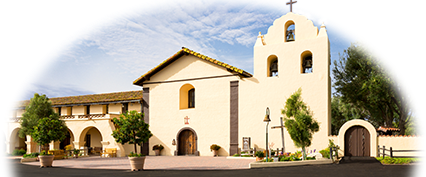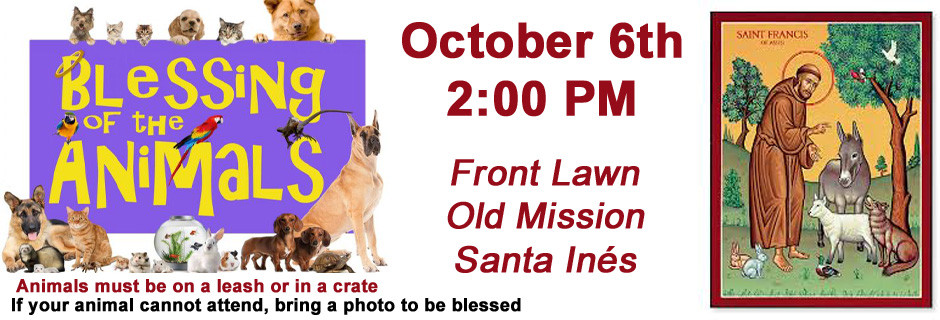Bring your pet animals for a blessing by Fr. Bobby on Sunday, October 6th at 2pm.
Please make sure your pet is safely secured on a leash or in an appropriate carrier for the blessing. If your pet is frightened of crowds, please leave your pet at home and instead, bring a symbol of your animal (photo, favorite toy, etc.) to the blessing.
All of the Santa Ynez Valley community is invited to join in.
The blessing of pets and animals is often celebrated on the Sunday nearest October 4, the feast of St. Francis of Assisi, the Patron Saint of Animals.
According to blog by John Sweeney:
St. Francis of Assisi started almost 800 years ago: blessing our animals. It was Francis who first introduced the idea that human beings are only one of a myriad of creations of God and all are blessed in God’s “eyes.” The feast day of St. Francis (the day that he died) is celebrated every year on October 4, and blessing of the animal services are usually scheduled for the Sunday closest to that day.
Whether you realize it or not, you probably know something about St. Francis. He is the most popular Catholic saint in the world. He is the one who preached to the birds; blessed fish that had been caught, releasing them back into the water; communicated with wolves, brokering an agreement between one famous ferocious wolf and the citizens of a town were terrified of it and used real animals when he created the very first, live, Christmas nativity scene. As a result of these, Francis is the patron saint of animals and the environment.
The first blessing of the animals happened like this: One warm afternoon early in his ministry (sometime between 1210-15), Francis wandered outside of Assisi, full of self-doubt, asking God if perhaps everything he had done until that point had been for the wrong reasons. Francis wondered if he should have simply gotten married and raised a family as his father wanted him to do. It was while he was praying alone to God that Francis glimpsed some birds along the path. He paused and began to speak to them as if to equals. Soon, he began to “preach” to them about God’s glories and all the reasons why both humans and birds should be grateful. That day marks the beginning of the environmental movement, the beginning of the era when we begin to understand ourselves as intrinsically connected to all of creation.
He exhibited sensitivity to the living and organic things around him that sets him apart from other people of his day and the saints who came before him. He even cared for the inanimate objects of creation with a sensitivity that is similar to Buddhist teachings about kindness toward all sentient beings. One of the most beautiful paragraphs of “The Golden Legend” by Jacobus of Voragine (a late medieval text about the lives of the saints) explains:
The saint would not handle lanterns and candles because he did not want to dim their brightness with his hands. He walked reverently on stones out of respect for him who was called Peter, which means stone. He lifted worms from the road for fear they might be trampled underfoot by passersby. Bees might perish in the cold of winter, so he had honey and fine wines set out for them. He called all animals brothers and sisters. When he looked at the sun, the moon, and the stars, he was filled with inexpressible joy by his love of the Creator and invited them all to love their Creator.
This connection between St. Francis and animals is the single fact about him that most people know. He emphasized that creation includes more than humankind. He always called creatures his brothers and sisters and he worked to further widen the fraternity to link humans and creatures in the same relationship with God. But was Francis really the first person to bless the animals? It appears not. Judaism, long home to blessings of all kinds, may have come first.
Many synagogues now have their own blessing of the animals ceremonies, and, they say, the idea originated in ancient Judaism. Without reference to Francis of Assisi (but occasionally, with a passing reference to him), the Jewish ceremony is often performed on the seventh day of Passover (in the spring) as a celebration of the Hebrews’ (and their animals’) emancipation from slavery in Egypt more than 3,000 years ago. Why not exult in the freedom of all creatures from bondage, and not just the humans? Such an occasion reminds humans to care for their pets as if they are more like companions than slaves.
Also, at this time of year, many Jewish congregations schedule blessings of the animals after the High Holy Days, centering their ceremonies around the second weekly Torah portion of the Jewish Year cycle: Parashat Noach, the portion about Noah and the ark. Way back then, God promised never to destroy the earth again — and both humans and animals were understandably joyful. On this occasion, animals are blessed as creatures, reminding humans how we share that essential quality with our pets. This October 28-29, the story of Noah will be read in synagogues around the U.S. for Shabbat Noach — and more synagogues than ever before will include an animal blessing in their services that would make a Franciscan feel at home.
I happened to be at Congregation Beth Simchat Torah in Greenwich Village a few years ago on Shabbat Noach. They had a special blessing for animals (mostly dogs) that day—something that they do every year. People and pets crowded the aisles and everyone who had a companion with fur in their lives received a ribbon attachable to a collar. It wasn’t quite the Cathedral of St. John the Divine on the Feast Day of St. Francis of Assisi, but it was terrific nonetheless.
In both the Christian ceremony performed in early October and in Jewish ceremonies later in the month, the message to those of us with animal companions is the same: take care of them as you would take care of yourself. Show gratitude; they are gifts from God.

